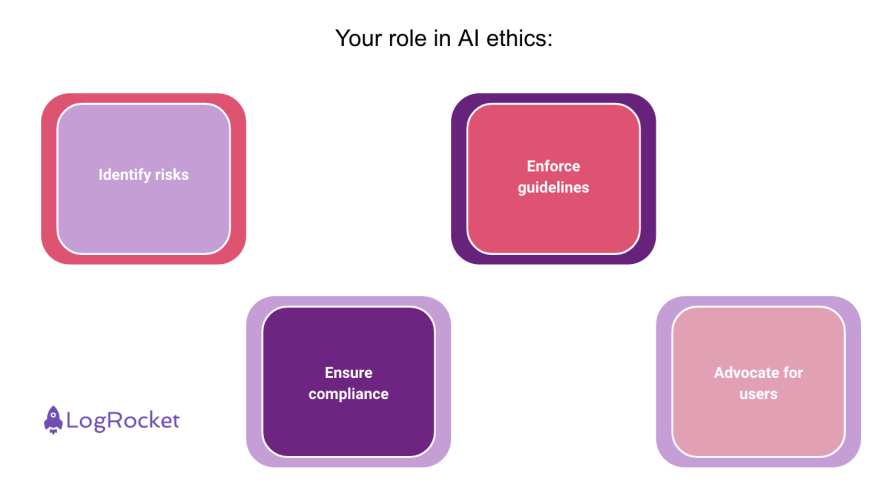Imagine a world where AI decides who gets a job, who qualifies for a loan, or even who receives critical healthcare. While this might sound scary, it might happen in the not so distant future. AI continues to play a bigger and bigger role in our lives and shows no signs of slowing down.

However, AI can hold biases that raise ethical concerns. As a product manager, how can you make sure that you use AI responsibly, fairly, and transparently? This article delves into the AI ethics, exploring how you can navigate the fine line between innovation and moral responsibility.
What are AI ethics?
AI ethics involve the moral and societal implications of AI. Because AI has become increasingly integrated into our society, it’s important that you ensure AI operates fairly and transparently.
Whether you’re an AI product manager who leads a team to build AI/ML models, or a product manager whose product adopts AI tools to enhance its capability or efficiency, understanding AI ethics can help you build responsible products.
Key ethical principles with AI
When technology mimics human behavior, it can inherit the same biases and issues that affect human judgment. Because of this, incorporate the following principles while training your AI model:

Fairness and bias
AI built on biased data leads to biased results; strive to reduce biases when gathering data for AI training models. Data should be free from biases related to race, gender, and age to provide fair outcomes for all users.
Biases can also appear in the algorithm and the predictions AI produces. Throughout every stage of AI development, you need to actively identify and mitigate biases. Otherwise, a flawed AI can reinforce existing societal disparities.
Transparency and explainability
Companies obtain enormous amounts of user data. Users, on the other hand, often feel worried about this. To build trust, ensure transparency and explainability.
Transparency refers to the clarity and openness you design, develop, and operate AI systems with. In other words, make sure your users and stakeholders understand how your AI systems make decisions.
Explainability involves the ability to describe and clarify the workings and decisions of AI systems in understandable terms. You should strive to produce interpretable AI models, where the internal workings can be easily understood by users.
Privacy and Security
Because AI and generative AI models rely on great amounts of data for training, privacy concerns arise. Users have a right to control how you collect, use, share, and store their personal data. AI systems must comply with regulations such as GDPR and the California Consumer Privacy Act (CCPA).
You also need to ensure security. Do everything in your power to avoid malicious attacks on your data. Establish protocols that everyone in your organization follows.
Accountability
With AI systems, you have many stakeholders from developers, organizations, and policymakers. It takes a group effort to hold AI accountable.
Implement oversight, impact assessment, audit, and due diligence mechanisms to avoid human rights conflicts and threats to environmental well-being. Within the near future, policymakers will roll out increased legislation to protect users.
Challenges and dilemmas for AI ethics
Machine and deep learning AI systems often operate as “black boxes.” The complexity and intricacy makes it extremely difficult for human beings to interpret or understand the decision-making process. Alongside this, companies may be reluctant to disclose details due to competitive and intellectual property concerns, which hinders trust and transparency.
If the AI training data contains biases, those biases can replicate and amplify within the system. Even with unbiased data, the algorithms can introduce bias due to how they process and interpret data.
Also, AI systems often work globally. This complicates accountability since different countries have different legal frameworks and standards.
Your role in AI ethics
As PM, AI inevitably influences your work. You play a key role in keeping AI systems from overstepping their bounds. Make sure to:

Identify risks
Make sure data collection and usage comply with privacy regulations and ethical standards. Help identify and mitigate biases in the training data, models, and outcomes. You should know how data is collected, how it’s used, and how it might reflect or perpetuate biases.
Enforce guidelines
While building products, integrate the company’s ethical guidelines into the product development process. Work with data scientists and the AI team to include regular reviews and audits of AI models in the development cycle. If ethical guidelines are missing, work with your legal team to create frameworks that align with the company’s values and requirements.
Ensure compliance
Besides enforcing the internal policies, partner with legal and compliance to understand the legal implications of AI products. Align ethical practices with the legal requirements. Stay informed about the latest regulations and standards related to AI ethics.
Advocate for users
Understand the impact AI has on users, especially minority groups. Design products with your user’s best interests in mind. Implement feedback loops for users to provide inputs on ethical concerns, and continuously improve the product based on user feedback.
Final thoughts
Rigorously apply the principles of AI ethics throughout your AI development process. You should always strive to deliver fair and equitable products.
As the PM, act as the bridge between technical teams and the broader impact of AI on society. By identifying ethical risks, enforcing ethical guidelines, ensuring compliance with legal standards, and advocating for users, you can help shape AI technologies that align with company values and societal expectations.
Featured image source: IconScout